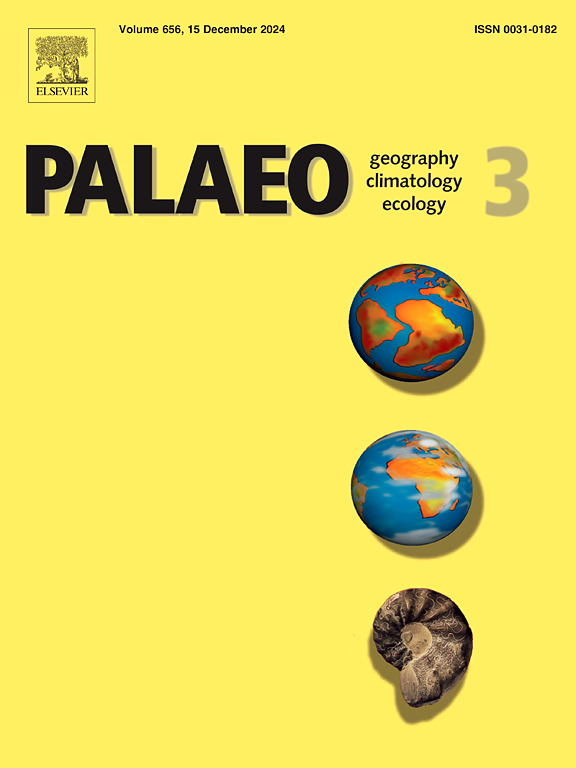Coffin timber from southeastern China as a tree-ring archive for paleoclimate research
IF 2.6
2区 地球科学
Q2 GEOGRAPHY, PHYSICAL
Palaeogeography, Palaeoclimatology, Palaeoecology
Pub Date : 2025-07-14
DOI:10.1016/j.palaeo.2025.113136
引用次数: 0
Abstract
Tree-ring chronologies provide high-resolution climate records, playing a crucial role in the study of paleoclimate and social history. In China, long chronologies are mainly concentrated on the Tibetan Plateau and surroundings, whereas those in southeastern China rarely exceed 200 years. To develop a longer chronology, we collected 315 coffin wood samples buried during the Song (960–1279 CE) to Ming Dynasty (1368–1644 CE) period from five archaeological sites in Changzhou, Jiangsu Province, in the lower Yangtze River basin. Using dendrochronological crossdating, we constructed a 344-year floating tree-ring width chronology spanning the late Tang to the Song Dynasty. Radiocarbon dating further constrained its temporal span to approximately 780 to 1150 CE. The chronology shows a significant positive correlation with solar irradiance, exhibiting notably reduced growth during the Oort solar minimum (∼1021–1060 CE) and intervals of weakened South Asian summer monsoon. We further identified temporal shifts in coffin types and wood selection. Compared with those from the Song dynasty, coffins from the Ming period exhibit a greater number of tree species and a higher proportion of fast-growing, young trees, reflecting the ongoing depletion of primary forests in the lower Yangtze region. Some large coffins relied on timber acquired through long-distance trade, increasing the diversity of wood sources and posing challenges for cross-dating. These findings suggest that coffin assemblages preserve not only climatic signals but also evidence of environmental change and shifting patterns of resource use.
中国东南部棺木作为古气候研究的年轮资料
树木年轮年表提供了高分辨率的气候记录,在古气候和社会历史研究中起着至关重要的作用。在中国,长年代学主要集中在青藏高原及其周边地区,东南部地区的年代学很少超过200年。为了建立一个更长的年表,我们在长江下游江苏省常州的五个考古遗址中收集了315个宋代(公元960-1279年)至明代(公元1368-1644年)的棺木样本。利用树木年轮交叉测年,我们构建了一个跨度为唐末至宋朝344年的浮动树木年轮宽度年表。放射性碳测年进一步将其时间跨度限制在大约公元780年至1150年之间。年代学与太阳辐照度呈显著正相关,在奥尔特太阳极小期(~ 1021 ~ 1060 CE)和南亚夏季风减弱期间,太阳辐照度显著减少。我们进一步确定了棺材类型和木材选择的时间变化。与宋代的棺木相比,明代棺木的树种数量更多,速生幼树比例更高,反映了长江下游地区原始森林的持续枯竭。一些大型棺材依赖于通过长途贸易获得的木材,增加了木材来源的多样性,并对交叉定年提出了挑战。这些发现表明,棺材组合不仅保存了气候信号,还保存了环境变化和资源利用模式转移的证据。
本文章由计算机程序翻译,如有差异,请以英文原文为准。
求助全文
约1分钟内获得全文
求助全文
来源期刊
CiteScore
5.90
自引率
10.00%
发文量
398
审稿时长
3.8 months
期刊介绍:
Palaeogeography, Palaeoclimatology, Palaeoecology is an international medium for the publication of high quality and multidisciplinary, original studies and comprehensive reviews in the field of palaeo-environmental geology. The journal aims at bringing together data with global implications from research in the many different disciplines involved in palaeo-environmental investigations.
By cutting across the boundaries of established sciences, it provides an interdisciplinary forum where issues of general interest can be discussed.

 求助内容:
求助内容: 应助结果提醒方式:
应助结果提醒方式:


